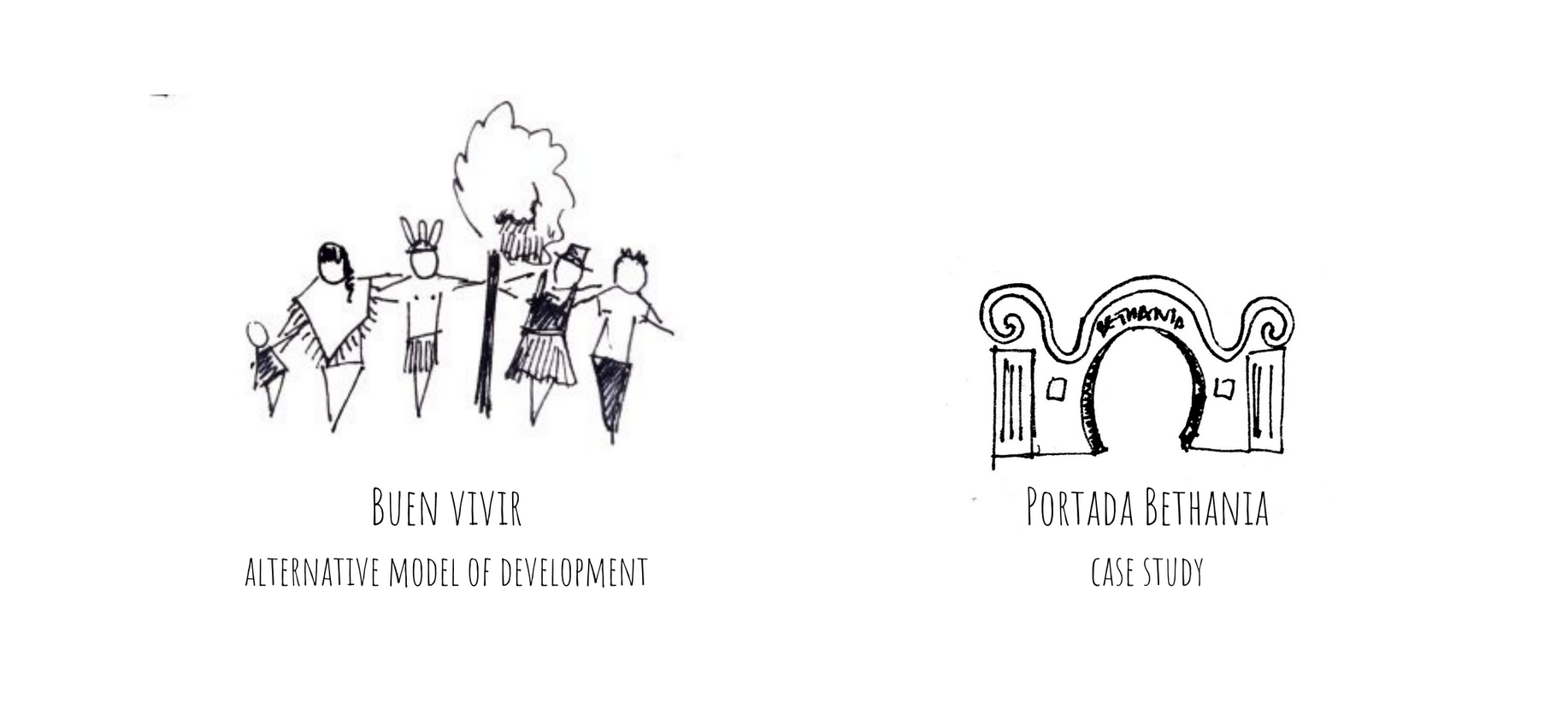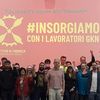note General note
Commoning for an alternative development: an Ecuadorian case of empirical application of Buen Vivir
This note is part of the Commoning Beyond Growth Workshop, which took place in Nottingham from June 5 to 7, 2024.
Cette note s'inscrit dans le colloque le Commoning au-delà de la croissance, qui a eu lieu à Nottingham du 5 au 7 juin 2024.
💡 Une traduction de la note en français est disponible plus bas.

In this presentation I’ll talk about the alternative model of development Buen Vivir, implemented in Ecuador, explaining how it was “implemented” and what are its differences to the hegemonic globalised model of development. Then I’ll present the case of the family cooperative Portada Bethania, a (initially credit and savings cooperative) as an empirical case of the application of many of the ideas of Buen Vivir.
Buen Vivir, or Sumak Kawsay (in Quechua) means “good living” or “well living”. This concept was integrated in the 2008 Ecuadorian National Constitution, during the governance of Rafael Correa. This socialist government - as others contemporaneous in Latin America - emerged as an alternative and answer to the critics and problems raised by neoliberalism of the 80’s - 90’s. As Acosta and Martínez mentions, this alternative proposal emerges from “a profound critique to the explosive, destructive and unfair model, which promoted the concentration of wealth, and that precluded the redistribution of it” (Acosta & Martínez, 2009). And facing this “civilising crisis, [and] the impossible continuity of the industrialist depredator model based in the fight of human being against nature and the identification of well-being and wealth to material goods accumulation” (Acosta & Martínez, 2009) this government proposed the integration of an anti capitalist vision in national constitutions, namely a vision strongly based in the Andean indigenous culture. This was also done in Bolivia. In Ecuador this proposal was mainly moved by Alberto Acosta, an economist and academic who developed this vision. This vision is based on an idea that the main factor for economic production and for development is the human being. In Acosta and Martínez’s words, this is “a project that fosters a balanced life among all individuals, with the collective and with nature (...) without pretending to dominate it” (Acosta & Martínez, 2009). And of course, as most political campaigns, this sounds amazing, but as with most political campaigns we ask “right, but how?”. Well in this case some of the proposed measures to “a balanced life among all individuals” were directed to immigrants, in the sense of giving them the same political, mobility and social protection rights as nationals. Besides there were also policies directed to the limitation of labour precarity, free access to university education, the fostering of the idea of food sovereignty and the support of practices of solidarity and familiar economies, through its institutionalisation in the Instituto de Economía Popular y Solidaria (IEPS). In terms of the protection of nature, the inclusion of nature as subject to legal rights was the biggest achievement in this sense. This opened the possibility of any individual to denounce the attack to nature’s rights in legal terms. This was an answer to the extractive activity in Ecuador, mainly of oil companies and mining. However, many authors critique these policies and also the way Buen Vivir was twisted to fit neoliberal and neoextractivist drives and needs (Kay & Vergara-Camus, 2018; Lang & Mokrani, 2013; Negri et al., 2013). More than debating on how it was or wasn’t achieved the ideals of Buen Vivir by the Correa’s government, I’d like to look at what did normal people, civilians do with this? One of the multiple things that surprised me the first time I went to Ecuador was the impact the implementation of this vision seemed to have had in many of the grassroots movements and alternative projects I met. So I decided to study one of the ones that most amazed me. Cooperativa Portada Bethania.
Portada Bethania starts initially as a familiar cooperative of credit and savings and grows to encompass new funds such as the Cars Insurance Fund, the Health Insurance Fund, the Common Good Fund and now, more recently, the Retirement Fund - which is in process of being created.
The project starts from the initiative of 8 siblings who decide to “move out of the system”. From a critique to the unfairness of the banking and financing system, they decide to create a savings and credit common fund that might enable them to get some level of financial autonomy. The official foundation of the cooperative happened in 2003. Most of the siblings were big supporters of Correa’s government and were strongly involved with indigenous communities through NGOs in processes of empowerment, facilitation, mediation and politicisation of local agents. Furthermore, they were also related with the leftwing political movement in Latin America more broadly, receiving victims of political persecution and activists in the leftwing movement in other latin american countries such as Cuba or Chile.
This political involvement and the proximity to indigenous peasant communities seems to be strongly related with the creation of this project since many of the visions defended in these political movements are present in the vision of the cooperative. One of the main axes of the cooperative is the concept of ‘solidarity’ associated with a strong sense of community. The community in this case is the family, since there is only the possibility of being a member if one is part of the family. On the other side, ‘solidarity’ is conceived in different ways from different people inside the cooperative. In general, I identified that mostly in the 1st generation (but not exclusively) conceived ‘solidarity’ as to help others who are in a worst situation - being it economical or wealthwise. This moved many projects of gathering money to help someone who was sick or that had some kind of emergency, for example.
On the other side, there is the vision of ‘solidarity’ as to help the others to be what they want to be. This vision is, in general, more common in the second generation of the family. And it has a bit of an anarchist background line of thought. This perspective gave rise to the Fund of Common Good1, seeing the opportunity of, with common money, concrete ideas for the immediate common good of the family - events or projects that could gather and unite the family. I heard many times that this fund was being called the Buen Vivir Fund by mistake, which shows the influence of this philosophy in the cooperative organisation.
These two visions result in two different models of governance. The idea of ‘solidarity’ as ‘to help others who need most’ results in a more centralised model of governance in which decisions pass through a filter of moral values of what is a need, what is solidarity, what is individualism, etc. On the other side, ‘solidarity’ as ‘help one to be what one wants’ results in a mode decentralised amoralist model of governance in which there is not much of a filter of the ethics behind personal decisions.
Furthermore, these two visions also create the tracks to different common futures inside the cooperative. The first vision of ‘solidarity’ results in the idea that the common goal should be to grow economically to be able to answer to other needs or emergencies in the future. On the other side, the other vision of ‘solidarity’ suggests that the common goal should be to use the resources actually available to answer to actual needs.
1 The interests of the conceived credits were initially divided to each member equally (as in other cooperatives). Later the Common Good Fund was created to manage this money. Instead of directly giving the interests to the members, the members have a fund with that amount of money but they can only have it if they propose a project in which this money should be used. The project is approved if 9 other people from the cooperative accept to also put that money in that project. The main idea is to channel the interest money to common good projects to unite and gather the family or to create common goods.
Even though, right now, the cooperative is struggling with having a common vision for the future of the collective that encompasses these different visions, what I find interesting is that both want some kind of independence from the bynom State-Market. The first one, is more about searching for independence of these institutions themselves (being able to conceive even bigger credits, or assurance of more and more complex emergencies) and the second one in searching for independence from what these institutions represent: the power and aim for money and economic growth.
Since the field work finished a very short time ago, more than a presentation of the conclusions resulting from the field work, this is more a compilation of the results of it, that I’d like to open to discussion.
Traduction en français
Traduction libre par Marie-Soleil L’Allier
Dans cette présentation, je vais parler du modèle alternatif de développement Buen Vivir, mis en œuvre en Équateur, en expliquant comment il a été "mis en œuvre" et quelles sont ses différences par rapport au modèle de développement hégémonique mondialisé. Ensuite, je présenterai le cas de la coopérative familiale Portada Bethania, initialement une coopérative de crédit et d'épargne, comme un cas empirique de l'application de nombreuses idées du Buen Vivir.
Buen Vivir, ou Sumak Kawsay (en Quechua), signifie "bien vivre". Ce concept a été intégré dans la Constitution nationale équatorienne de 2008, sous la gouvernance de Rafael Correa. Ce gouvernement socialiste – comme d'autres contemporains en Amérique latine – est apparu comme une alternative et une réponse aux critiques et problèmes soulevés par le néolibéralisme des années 80 et 90. Comme le mentionnent Acosta et Martínez, cette proposition alternative émerge d' "une critique profonde du modèle explosif, destructeur et injuste, qui a favorisé la concentration de la richesse et empêché sa redistribution" (Acosta & Martínez, 2009). Face à cette "crise de civilisation, [et] l'impossible continuité du modèle industriel prédateur basé sur la lutte de l'homme contre la nature et l'identification du bien-être et de la richesse à l'accumulation de biens matériels" (Acosta & Martínez, 2009), ce gouvernement a proposé l'intégration d'une vision anti-capitaliste dans les constitutions nationales, notamment une vision fortement basée sur la culture indigène andine. Cela a également été fait en Bolivie. En Équateur, cette proposition a été principalement portée par Alberto Acosta, un économiste et universitaire qui a développé cette vision. Cette vision repose sur l'idée que le facteur principal de la production économique et du développement est l'être humain. Selon Acosta et Martínez, c'est "un projet qui favorise une vie équilibrée entre tous les individus, avec le collectif et avec la nature (...) sans prétendre la dominer" (Acosta & Martínez, 2009). Et bien sûr, comme la plupart des campagnes politiques, cela semble formidable, mais comme pour la plupart des campagnes politiques, nous nous demandons "d'accord, mais comment ?". Eh bien, dans ce cas, certaines des mesures proposées pour "une vie équilibrée entre tous les individus" étaient destinées aux immigrants, dans le sens de leur donner les mêmes droits politiques, de mobilité et de protection sociale que les nationaux. En outre, il y avait aussi des politiques visant à limiter la précarité du travail, à garantir l'accès gratuit à l'éducation universitaire, à promouvoir l'idée de la souveraineté alimentaire et à soutenir les pratiques de solidarité et d'économies familiales, grâce à leur institutionnalisation dans l'Instituto de Economía Popular y Solidaria (IEPS). En termes de protection de la nature, l'inclusion de la nature en tant que sujet de droits juridiques a été la plus grande réalisation dans ce sens. Cela a ouvert la possibilité à tout individu de dénoncer les atteintes aux droits de la nature en termes juridiques. Cela a été une réponse à l'activité extractive en Équateur, principalement des compagnies pétrolières et minières. Cependant, de nombreux auteurs critiquent ces politiques et aussi la manière dont Buen Vivir a été déformé pour répondre aux besoins et objectifs néolibéraux et néoextractivistes (Kay & Vergara-Camus, 2018 ; Lang & Mokrani, 2013 ; Negri et al., 2013). Plutôt que de débattre sur la façon dont les idéaux du Buen Vivir ont été ou non atteints par le gouvernement de Correa, je voudrais examiner ce que les gens ordinaires, les civils, en ont fait. Une des nombreuses choses qui m'ont surpris la première fois que je suis allé en Équateur, c'est l'impact que la mise en œuvre de cette vision semblait avoir eu sur de nombreux mouvements de base et projets alternatifs que j'ai rencontrés. J'ai donc décidé d'étudier l'un de ceux qui m'ont le plus étonné : la Cooperativa Portada Bethania.
Portada Bethania commence initialement comme une coopérative familiale de crédit et d'épargne et s'élargit pour inclure de nouveaux fonds tels que le Fonds d'assurance automobile, le Fonds d'assurance santé, le Fonds du bien commun et, plus récemment, le Fonds de retraite – qui est en cours de création.
Le projet commence par l'initiative de 8 frères et sœurs qui décident de "sortir du système". Partant d'une critique de l'injustice du système bancaire et financier, ils décident de créer un fonds commun d'épargne et de crédit qui pourrait leur permettre d'obtenir un certain niveau d'autonomie financière. La fondation officielle de la coopérative a eu lieu en 2003. La plupart des frères et sœurs étaient de grands partisans du gouvernement de Correa et étaient fortement impliqués avec les communautés indigènes à travers des ONG dans des processus d'autonomisation, de facilitation, de médiation et de politisation des agents locaux. En outre, ils étaient également liés au mouvement politique de gauche en Amérique latine de manière plus générale, recevant des victimes de persécution politique et des activistes du mouvement de gauche dans d'autres pays d'Amérique latine tels que Cuba ou le Chili.
Cette implication politique et la proximité avec les communautés paysannes indigènes semblent être fortement liées à la création de ce projet, car de nombreuses visions défendues dans ces mouvements politiques sont présentes dans la vision de la coopérative. Un des principaux axes de la coopérative est le concept de 'solidarité' associé à un fort sentiment de communauté. La communauté, dans ce cas, est la famille, puisqu'il n'y a que la possibilité de devenir membre si l'on fait partie de la famille. D'un autre côté, la 'solidarité' est conçue de différentes manières par différentes personnes au sein de la coopérative. En général, j'ai identifié que principalement dans la 1ère génération (mais pas exclusivement), la 'solidarité' est conçue comme aider les autres qui sont dans une situation pire – que ce soit sur le plan économique ou matériel. Cela a conduit à de nombreux projets de collecte de fonds pour aider quelqu'un qui était malade ou qui avait une urgence, par exemple.
D'un autre côté, il y a la vision de la 'solidarité' comme aider les autres à être ce qu'ils veulent être. Cette vision est, en général, plus courante dans la deuxième génération de la famille. Et elle a un peu une ligne de pensée anarchiste en arrière-plan. Cette perspective a donné naissance au Fonds du Bien Commun, voyant l'opportunité, avec de l'argent commun, de concrétiser des idées pour le bien commun immédiat de la famille – des événements ou des projets qui pourraient rassembler et unir la famille. J'ai souvent entendu dire que ce fonds était appelé par erreur le Fonds du Buen Vivir, ce qui montre l'influence de cette philosophie dans l'organisation de la coopérative.
Ces deux visions aboutissent à deux modèles de gouvernance différents. L'idée de 'solidarité' comme 'aider ceux qui en ont le plus besoin' aboutit à un modèle de gouvernance plus centralisé dans lequel les décisions passent par un filtre de valeurs morales de ce qui est un besoin, ce qu'est la solidarité, ce qu'est l'individualisme, etc. D'un autre côté, la 'solidarité' comme 'aider quelqu'un à être ce qu'il veut' aboutit à un modèle de gouvernance décentralisé et amoraliste dans lequel il n'y a pas beaucoup de filtre sur l'éthique derrière les décisions personnelles.
De plus, ces deux visions créent également les bases de futurs communs différents au sein de la coopérative. La première vision de la 'solidarité' aboutit à l'idée que l'objectif commun devrait être de croître économiquement pour pouvoir répondre à d'autres besoins ou urgences à l'avenir. D'un autre côté, l'autre vision de la 'solidarité' suggère que l'objectif commun devrait être d'utiliser les ressources disponibles pour répondre aux besoins actuels.
Bien que, pour le moment, la coopérative lutte pour avoir une vision commune de l'avenir du collectif qui englobe ces différentes visions, ce que je trouve intéressant, c'est que les deux recherchent une certaine indépendance par rapport au binôme État-Marché. La première recherche l'indépendance vis-à-vis de ces institutions elles-mêmes (pouvoir concevoir des crédits encore plus importants, ou garantir des urgences de plus en plus complexes) et la seconde recherche l'indépendance de ce que ces institutions représentent : le pouvoir et la quête de l'argent et de la croissance économique.
Comme le travail de terrain s'est terminé il y a très peu de temps, plutôt qu'une présentation des conclusions résultant du travail de terrain, il s'agit plus d'une compilation des résultats que je souhaite ouvrir à la discussion.
References
Acosta, A. & Martínez, E. (2009) El Buen Vivir: Una vía para el desarrollo. Quito: Ediciones Abya-Yala.
Hidalgo, M., Guerrero, F., Larrea, A. M., Larrea F., Muñoz, J.P., Ortiz, S., Tola, B., Torres, V. H & Unda, M. (1999) Ciudadanías Emergentes: Experiencias democráticas de desarrollo local. Quito: Ediciones Abya-Yala.
Kay, C. & Vergara-Camus, L. (2018). La Cuestión Agraria y los Gobiernos de Izquierda en América Latina: Campesinos, agronegocio y neodesarrollismo. Buenos Aires: CLASCO.
Lang, M. & Mokrani, D. (2013) Beyond Development: Alternative visions from Latin America. Transnational Institute/Rosa Luxemburg Foundation.
Martínez, L. (2009). La pluriactividad entre los pequeños productores rurales: el caso ecuatoriano. In H. Grammont & L. Martínez (Eds.) La pluriactividad en el campo latinoamericano. FLACSO. pp.81-101.
Negri, A., Hardt, M. & Mezzadra, S. (2013) Biocapitalismo, procesos de gobierno y movimientos sociales. Quito: FLACSO.
note Linked note(s)
 5 June 2024
5 June 2024
Catarina Lopes Mateus
5 June 2024 12 June 2024
12 June 2024
Presentation of the notebook | Commoning beyond growth
12 June 2024 21 February 2024
21 February 2024
Marie-Soleil L’Allier s'intéresse aux communs
21 February 2024Linked notebook(s)
 file_copy
61 notes
file_copy
61 notes
Commoning Beyond Growth
file_copy 61 notesAuthor(s) of note
Contact the authorLinked community
Commoning Beyond Growth
More informationPublished
June 12, 2024
Edited
June 20, 2024, 2:45 p.m.
Licence
Alert: a part or the whole of this content might not be the property of the author or authors of the note. If needed, find out about conditions for re-use.
Visibility
public
Quote this note
Marie-Soleil L'Allier. (2024). Commoning for an alternative development: an Ecuadorian case of empirical application of Buen Vivir. Praxis (consulted July 19, 2024), https://praxis.encommun.io/en/n/tItl9zyys2hkO-YbNCLqbBLRzGY/.
shareCopy